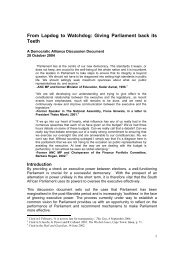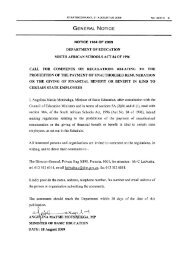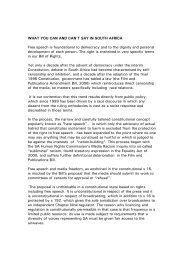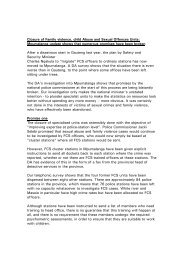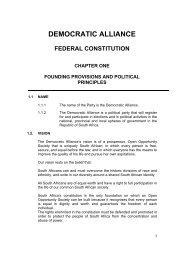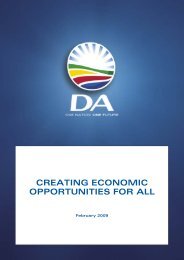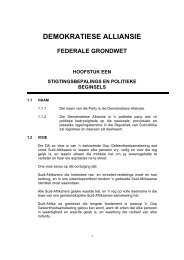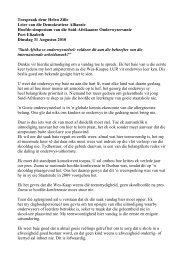DA's Plan for Growth and Jobs - Democratic Alliance
DA's Plan for Growth and Jobs - Democratic Alliance
DA's Plan for Growth and Jobs - Democratic Alliance
You also want an ePaper? Increase the reach of your titles
YUMPU automatically turns print PDFs into web optimized ePapers that Google loves.
PreambleThe 8% <strong>Growth</strong> Project is the <strong>Democratic</strong> <strong>Alliance</strong>’s policy agenda <strong>for</strong> economic change thatwill open job opportunities to millions of South Africans. It sets out how we will work tochange our economy from one that grows at 3% per year, to one that grows at 8%.Economies like Peru, Singapore, <strong>and</strong> Vietnam have all recently achieved annual growthrates of 8%, <strong>and</strong> their average growth rates have exceeded 6% over the past decade. Thishas allowed them to achieve extraordinary results in tackling social ills like poverty,unemployment <strong>and</strong> inequality.South Africa, on the other h<strong>and</strong>, has averaged only 3.6% growth in GDP over the pastdecade, reaching a high of 5.6% in the boom years of 2006 <strong>and</strong> 2007. This has not beensufficient to significantly roll back unemployment, or provide opportunities <strong>for</strong> people to liftthemselves out of poverty.Economic growth is the essential ingredient. No country has created jobs without growth.There are many constraints to growth in our country, but underpinning them all is the factthat too many South Africans are left out of the economy <strong>and</strong> are unable to make acontribution to driving growth because they can’t find work; they can’t attain skills; they can’tstart businesses; <strong>and</strong> they lack access to capital assets.In short, too few people in South Africa actively participate in the country’s economy.You can see this from South Africa’s labour market where our unemployment rate hasaveraged 27% (using the narrow definition of unemployment) over the past decade. This isby far the highest of any developed country or emerging market in the world <strong>and</strong> three timeshigher than unemployment rates in Brazil, Turkey <strong>and</strong> Ghana.And you can see it in the state of entrepreneurship in South Africa where only 9.1% of theeligible population is engaged in entrepreneurial activity. This is less than half the proportionin comparable middle-income developing countries such as Argentina, Thail<strong>and</strong> or Chile.The apartheid government denied millions of South Africans access to economicopportunities <strong>and</strong> built an economy of insiders <strong>and</strong> outsiders, principally dominated by largestate <strong>and</strong> private companies.Eighteen years after the end of apartheid, this basic structure has not changed, <strong>and</strong> SouthAfrica remains a country of insiders <strong>and</strong> outsiders with Big Government, Big Unions <strong>and</strong>some anti-competitive Big Businesses on one side, <strong>and</strong> millions of ordinary of South Africanson the other.The DA’s solution is to make markets work <strong>for</strong> the many, not just the few. The state has aresponsibility to intervene when markets fail, but also when powerful public <strong>and</strong> privatesector players abuse their market power at the expense of others.This is central to the DA’s vision of a state that provides an enabling environment <strong>for</strong>economic growth by ensuring access to markets, credit <strong>and</strong> skills; limiting negativeexternalities; attracting trade <strong>and</strong> investment, <strong>and</strong> ensuring the economy has theinfrastructure it needs in order to grow.The policies here take us a step closer to fulfilling this vision at national level.9 | P a g e




